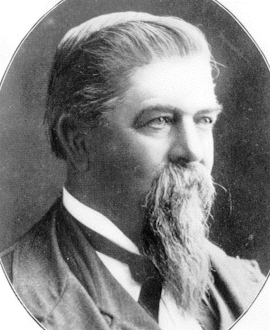Benjamin Harrison Eaton facts for kids
Quick facts for kids
Benjamin Harrison Eaton
|
|
|---|---|
 |
|
| 4th Governor of Colorado | |
| In office January 13, 1885 – January 11, 1887 |
|
| Lieutenant | Peter W. Breene |
| Preceded by | James B. Grant |
| Succeeded by | Alva Adams |
| Personal details | |
| Born | December 15, 1833 Coshocton, Ohio |
| Died | October 29, 1904 (aged 70) Greeley, Colorado |
| Political party | Republican |
Benjamin Harrison Eaton (born December 15, 1833 – died October 29, 1904) was an important American politician and businessman. He was also a skilled farmer in the late 1800s and early 1900s.
Eaton helped start the Greeley Colony. He was key in bringing modern irrigation (a way to water crops) to Northern Colorado. As a member of the Republican Party, he became the fourth Governor of Colorado. He served from January 1885 to January 1887. People often called him the "farmer governor."
He owned a lot of land in Weld and Larimer counties. He built many canals and reservoirs to water his farms. His projects helped turn the South Platte River valley into a major farming area. The town of Eaton, Colorado is named after him.
Eaton is one of sixteen important pioneers from Colorado. You can see his image in stained glass at the Colorado State Capitol Building.
Contents
Early Life and Moves West
Benjamin Eaton was born in Coshocton, Ohio. He was one of eight children. He went to school and later taught in West Bedford, Ohio.
In 1854, when he was 21, he moved to Louisa County, Iowa. He taught school there for two years. He went back to Ohio in 1856 and married Delilah Wolf. Sadly, his wife died in 1857 after their son, Aaron James Eaton, was born.
Adventures in Colorado
Eaton moved to Colorado in 1858 during the Colorado Gold Rush. He looked for gold in Colorado and New Mexico. He also worked on farms. During the American Civil War, he served with Colonel Kit Carson.
In 1863, he built a farm near where Windsor, Colorado, is today.
Family and Community Role
In 1864, Eaton returned to Iowa and married Rebecca J. Hill. They traveled across the Great Plains to Weld County, Colorado. There, they started a livestock (farm animals) business.
He became an important person in Fort Collins. He was a founding member of the Masonic Lodge there. For nine years, he served as a Justice of the Peace. He was also a county commissioner for six years. Benjamin and Rebecca had three children: Lincoln, Bruce, and Jennie.
Building Colorado's Future
In 1870, Eaton met Nathan Meeker. Meeker was sent by Horace Greeley to find a good spot for the Union Colony. Eaton suggested land near the South Platte and Poudre Rivers. He promised to help build the ditches needed for the colony's farms.
The Union Colonists bought 60,000 acres of land. On March 15, 1870, they named their new town "Greeley." Building the 35-mile Canal No. 1 was hard work. But Eaton kept pushing until it was done.
Irrigation Projects
Eaton started building irrigation canals and reservoirs. He believed this would bring growth and wealth to Larimer and Weld Counties. In 1873, he helped build Larimer County Canal No. 2. This canal watered large areas around Fort Collins.
Water was very important, and sometimes there were arguments over it. In 1874, a dispute almost led to fighting between Fort Collins and Greeley. Eaton helped calm things down. He promised to share the water fairly, though it rained and solved the problem that time.
In 1878, he began building the Larimer and Weld Canal, also known as the Eaton Ditch. This was the biggest and longest irrigation canal in Colorado. It watered 50,000 acres of land. In 1879, he also built the High Line Canal in Denver for British investors. He built many other water projects too. Benjamin Eaton passed away in 1904 in Greeley.
Images for kids


